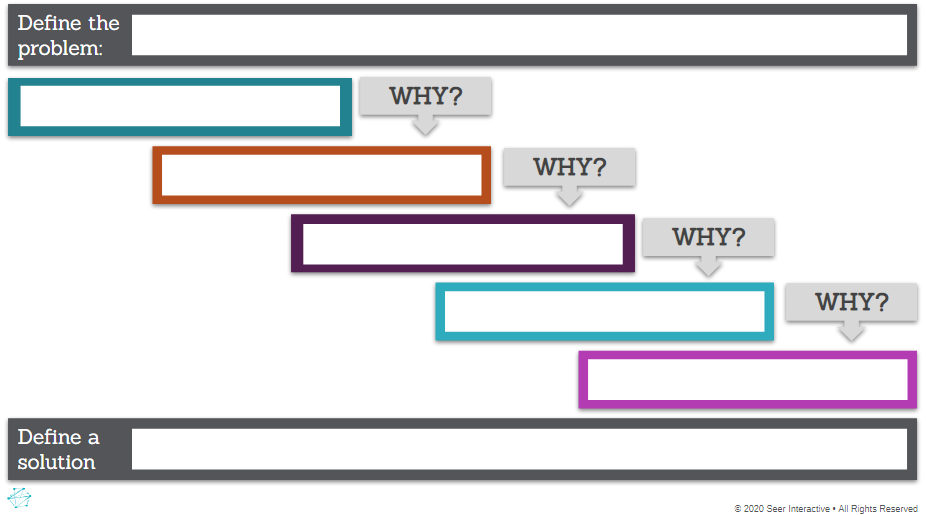Asking "why" until you get to the root cause is a skill that's beneficial in many facets of digital marketing. Learn about the 5 Whys and when to use them.
A big part of being a digital marketing consultant is coming up with solutions to problems and challenges. But if we don’t properly understand the origin of a problem, we’re more likely to tackle a symptom instead of the problem itself. Fortunately, there’s a pretty simple and efficient process that we can use to get to the root cause of almost any issue:
Ask “Why” Five Times
If you ask why over and over until you identify the root cause, you can be sure that you’re addressing the actual problem, and therefore suggesting an effective solution. Five is just a suggestion; you may get to the root cause in fewer or more steps than that, but it’s a good rule of thumb to get started
The 5 Whys can be applied in several different facets of digital marketing:
 Audience Analysis
Audience Analysis
At Seer, everything starts with people. We use audience analysis and research on every project in order to capture the voice of the customer and understand their pain points, needs, and motivations. When conducting audience interviews, the 5 Whys can help marketers understand the root cause of audience pain points.
Example: For a small business financing client, we interviewed small business owners who were looking for funding solutions.
- Problem: A small business owner had to turn down a large project.
- Why? She didn’t have the funds to afford upfront costs.
- Why? 90% of her expenses went to payroll.
- Why? The business had very little cash flow.
- Final Why/Root Cause: She paid her vendors on net 30 terms, but her clients paid her on net 60 terms, leading to 30+ day gaps in cash flow
Solution: We recommended creating content on our client’s site that positioned them as a solution for cash flow gaps.
 Client Challenges
Client Challenges
Digging into root causes with clients can help to efficiently and effectively solve their problems, improve performance, and deepen the relationship.
Example: Here’s a problem that’s probably familiar to many SEO consultants: implementation woes!
- Problem: We weren’t hitting organic traffic and revenue goals for a client.
- Why? The client wasn’t able to implement 90% of our recommendations.
- Why? Their dev team had very little bandwidth and deprioritized the SEO recommendations to focus on other tasks.
- Why? They didn’t understand the SEO recommendations.
- Why? The recommendations weren’t delivered in the standard format that they preferred.
- Why? The dev team hadn’t told the marketing team about their format requirements, so the marketing team hadn’t told us.
- Final Why/Root Cause: Lack of communication between dev, marketing, and Seer.
Solution: We set up a meeting with the dev team and marketing team to discuss workflow and recommendations formatting. Once we aligned on those items, we were able to format our recommendations in a way that made sense to the dev team, and they were able to work through the backlog and implement the outstanding SEO items.
 Leveling Up Team Members
Leveling Up Team Members
One of the best things about being a senior manager at Seer is that I have the opportunity to mentor associates and help them level up to become managers if that’s the career path they decide to pursue. So if there’s anything that’s holding them back from becoming a manager, we can work on the 5 Whys together to get to the root cause.
Example: I once worked with an associate who was really strong with SEO strategy but was lacking in some client communication skills.
- Problem: The project associate wasn’t speaking up in or contributing to client meetings.
- Why? While he was smart and talented, he was fairly green and lacked confidence.
- Why? He was afraid that he’d say the wrong thing on a call, or make a mistake and feel stupid.
- Why? He didn’t feel that he was prepared enough for calls.
- Final Why/Root Cause: He needed more internal preparation than we’d been doing.
Solution: Before every client meeting, we’d be sure to review the agendas ahead of time in detail and determine who would speak to which strategies. I worked with him to anticipate client questions and help guide him towards the right answers so that he’d feel confident on calls. I also helped him to understand that it’s okay to not have an answer 100% of the time and that it’s fine to say something like “I don’t have an answer for you right now but I’ll do some research and get back to you ASAP.” Soon after we made these changes, he gained some confidence and began speaking up more and more during meetings.
Conclusion
This simple framework can help digital marketers get to the root cause of almost any challenge quickly and efficiently. Try it out next time you’re working through a problem; use this handy template if you like:

Want more posts like this in your inbox? Sign up for our newsletter below!



